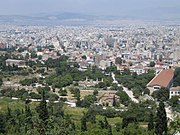The Ancient Agora of Athens is the most well-known example of agora, located in Athens, Greece.
History

The agora in Athens had private housing, until it was reorganized by Peisistratus in the 6th century BC. Although he may have lived on the agora himself, he removed the other houses, closed wells, and made it the centre of Athenian government. He also built a drainage system, fountains and a temple to the Olympian gods. Cimon later improved the agora by constructing new buildings and planting trees. In the 5th century BC there were temples constructed to Hephaestus, Zeus and Apollo.
The Areopagus and the assembly of all citizens met elsewhere in Athens, but some public meetings, such as those to discuss ostracism, were held in the agora. Beginning in the period of the radical democracy (after 509 BC), the Boule, or city council, the Prytaneis, or presidents of the council, and the Archons, or magistrates, all met in the agora. The law courts were located there, and any citizen who happened to be in the agora when a case was being heard, could be forced to serve as a juror; the Scythian archers, a kind of mercenary police force, often wandered the agora specifically looking for jurors.
The agora in Athens again became a residential area during Roman and Byzantine times.
Buildings and structures of the classical agora

- Peristylar Court
- Mint
- Enneacrounos
- South stoa
- Heliaea
- Strategeion
- Colonos Agoraios
- Tholos
- Agora stone
- Monument of the Eponymous Heroes
- Metroon (Old Bouleuterion)
- New Bouleuterion
- Temple of Hephaestus (Hephaestion)
- Temple of Apollo Patroos
- Stoa of Zeus
- Altar of the Twelve Gods
- Stoa Basileios (Royal stoa)
- Temple of Aphrodite Urania
- Stoa of Hermes
- Stoa poikile
Later buildings added to the site
A number of buildings were added to the agora. Those in place by the 2nd century included:
- The Middle stoa which sat across the sanctuary, infront of the Heliaea.
- A small Roman temple was added in front of the Middle stoa.
- An Altar of Zeus Agoraios was added just to the east of the Monument to the Eponymous Heroes.
- The Temple of Ares was added in the north half agora, just south of the Altar of the Twelve Gods.
- The Odeon of Agrippa and accompanying gymansium were added in the centre of the agora.
- The substantial Stoa of Attalos was built along the eastern edge of the agora.
- A collection of buildings were added to the south-east corner: the East stoa, the Library of Pantainos, the Nimphaeum and a temple.
Excavations
The modern excavation of the agora in Athens began in part under the direction of T. Leslie Shear, Sr. of the American School of Classical Studies in Athens. They continue to the present day, now under the direction of John McK Camp.[1]
After the initial phase of excavation, in the 1950's, part of the agora was landscaped and the Stoa of Attalos was rebuilt to serve as museum and work space - it now houses all the finds from the site.[2]
The Roman Forum of Athens
The Roman Forum of Athens is located to the north of the acropolis and to the east of the original classical Greek agora.



No comments:
Post a Comment